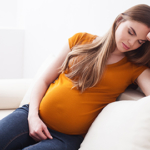About 15% of women experience a depressive episode after the birth of a child. While most women presenting with depressive symptoms have unipolar depression, some women actually have bipolar depression. At this juncture, making the correct diagnosis is vital, as the treatment of bipolar depression differs from the treatments typically used for unipolar depression in this setting. The use of antidepressants in a woman with bipolar disorder may not be effective and may actually make the symptoms worse.
While women with pregravid bipolar disorder may experience mana or postpartum psychosis after childbirth, it is important to remember that it is actually more common for women to experience depressive symptoms in this setting.
First, A Thorough Review of Psychiatric History
The first step in making this distinction is a careful review of past psychiatric symptoms. The following questions will help clinicians to identify individuals with a history of bipolar disorder, or symptoms suggestive of bipolar disorder:
- Has the patient previously received a diagnosis of bipolar disorder?
- Has the patient previously been treated with mood stabilizers, such as lithium, lamotrigine, or atypical antipsychotic agents?
- Does the patient have a history of mania or hypomania? The Mood Disorders Questionnaire or MDQ is a standardized questionnaire that can be helpful in screening for manic or mixed symptoms. Here is a printable version of the MDQ.
- Is there a family history of bipolar disorder? If one parent has bipolar disorder, there is a 10% to 25% chance of having bipolar disorder. The risk is higher if multiple family members are affected.
In individuals presenting with postpartum depressive symptoms, making the correct diagnosis can be tricky. It is not difficult to recognize a full-blown manic episode; however, most women with bipolar disorder do not present with classic manic symptoms. In fact, for many women with bipolar disorder, depressive episodes are more common than manic episodes. It is fairly common for the first episode of bipolar disorder to be depressive in nature, and this episode may occur prior to the onset of a hypomanic or manic episode.
Making the Diagnosis in Women with No History of Bipolar Disorder
When there is no history of bipolar disorder, is it possible to distinguish unipolar from bipolar depression? In a study of a large cohort of patients with bipolar disorder, researchers attempted to identify clinical and demographic features that could help clinicians distinguish bipolar from unipolar depression in postpartum individuals.
Using data from the FACE-BD (FondaMental Academic Centers of Expertise for Bipolar Disorders), a French multicenter cohort of patients with bipolar disorder, researchers identified all women who reported a major depressive episode as the first episode of bipolar illness and who had at least one child. They compared two groups of women, depending whether the onset of bipolar illness occurred during or outside of the postpartum period.
Among the 759 women in this cohort, 93 (12.2%) experienced postpartum onset of bipolar illness, and 666 (87.8%) experienced onset outside of the postpartum period. Women who had postpartum onset of bipolar disorder had a more stable family life, more children, and were older at age at illness onset. They were more likely to have Bipolar Disorder Type 2, less likely to hav e history of suicide attempts, and had fewer depressive episodes.
While this is one of the few studies looking at the features which may help clinicians to distinguish unipolar from bipolar postpartum depression, the information is of limited clinical utility. Nonetheless, it may provide some reassurance; the onset of bipolar disorder (with depression) during the postpartum period is less common than non-postpartum onset. Furthermore, it appears that women who present with bipolar depression during the postpartum period tend to have less severe illness (fewer depressive episodes, fewer suicide attempts, lower risk for mania) and have higher levels of family support.
Using the Mood Disorder Questionnaire to Identify Bipolar Depression
Vigilance is required in screening women who present with depressive symptoms during the postpartum period. Women with bipolar depression, as well as unipolar depression, typically present with elevated scores on the Edinburgh Postnatal Depression Scale. In one study where the EPDS was used to screen postpartum women, about a third of the women with a positive screen on the EPDS did not have unipolar depression but actually had bipolar disorder. In other words, if we were using the EPDS as our only tool to guide diagnosis and treatment, we would be wrong about 30% of the time.
A recent study evaluated the capacity of the Mood Disorder Questionnaire (MDQ) to identify bipolar disorder in perinatal individuals who screened positive for depression on the Patient Health Questionnaire-9, a screening tool commonly used to identify depression in perinatal populations (Millan et al, 2023).
Between January 2017 and April 2021, 1510 pregnant or postpartum individuals were included in this study. In this group of perinatal individuals who scored positive on the PHQ-9 (cutoff 10 or greater), 62 (4.1%) were diagnosed with bipolar disorder that was confirmed with a clinical evaluation using Diagnostic and Statistical Manual of Mental Disorders, Fifth Edition, diagnostic criteria.
The first question of the MDQ includes 13 “yes” or “no” items about current and past bipolar symptoms. While a score of 7 or greater on Question 1 of the MDQ is typically used to identify individuals with bipolar disorder in the general population, this cutoff when used in the perinatal population had a 60% sensitivity and 88% specificity. This means that if we used a cutoff score of 7, about 40% of the individuals screening positive on the PHQ-9 would be misdiagnosed with unipolar depression, when in fact they had bipolar depression.
Lowering the cutoff score of the MDQ to 4 or greater resulted in increased sensitivity (81%), at the expense of specificity (69%). This modification may lead to a greater number of false positives (patients who actually have unipolar depression); however, it reduces the likelihood of misidentifying individuals with bipolar disorder.
This study suggests that as an adjunct to routine screening with the EPDS or the PHQ-9, the administration of the Mood Disorder Questionnaire during the perinatal period can help to identify which individuals are more likely to have bipolar or unipolar disorder. In this context, the researchers observed that lowering the cutoff score for the MDQ to 4 or greater reduces the risk of a missed diagnosis of bipolar disorder.
Some Final Thoughts
The diagnosis of bipolar depression in the postpartum period can be extremely challenging, and even the most seasoned clinicians may struggle to accurately distinguish unipolar from bipolar depression in this setting. While the use of standardized screening tools may help to identify a greater number of women with psychiatric illness during the perinatal period, it is important to recognize that screening tools are not a substitute for clinical diagnosis. They merely identify those who need a more thorough evaluation.
Using screening tools like the EPDS or PHQ-9 identify women with a wide array of psychiatric disorders, including major depressive disorder, bipolar disorder, PTSD, generalized anxiety disorder. Further evaluation is required to confirm the diagnosis. In situations where there is limited access to mental health resources, the use of additional screening tools, such as the Mood Disorder Questionnaire may help clinicians to identify women with bipolar disorder and to ensure that these individuals receive the appropriate care.
Ruta Nonacs, MD PhD
REFERENCES
Millan DM, Clark CT, Sakowicz A, Grobman WA, Miller ES. Optimization of the Mood Disorder Questionnaire in identification of perinatal bipolar disorder. Am J Obstet Gynecol MFM. 2023 Jan;5(1):100777.
Tebeka S, Godin O, Mazer N, Bellivier F, et al. Clinical characteristics of bipolar disorders with postpartum depressive onset. Prog Neuropsychopharmacol Biol Psychiatry. 2020 Dec 18.
Using the EPDS During Pregnancy: What Exactly are We Screening For?
What Screening Tools Identify Postpartum Women with Bipolar Disorder?
Screening for Depression During Pregnancy May Lead to Misdiagnosis for Women with Bipolar Disorder







Leave A Comment